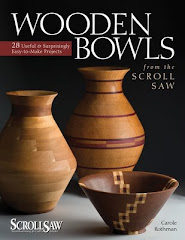Recently, I've seen a couple of posts from folks who are confused about table tilt and cutting direction. This comes up with bowls, inlay, and other situations where you need to cut at an angle. It's not that complicated, but easy to get confused. Here are some basics:
1. Most saw tables will tilt fully in either direction, but not all. If they tilt in only one direction, it is usually left side down. If yours tilts right side down, or if you prefer that orientation, just reverse the direction of the cut from what's given in the instructions. In other words, left side down clockwise is the same as right side down counterclockwise.
2. Cutting clockwise means that you move the wood in a counterclockwise direction. The blade gives the illusion that it is cutting clockwise. When the table is tilted left side down, the resulting cut will be larger on the upper face than on the lower face.
3. Cutting counterclockwise means that you move the wood in a clockwise direction. When the table is tilted left side down, the resulting cut will be smaller on the upper face than the lower face.
I use counterclockwise cutting for my projects primarily when I know the smaller dimension, not the larger one, as when creating a neck or a base. If you're ever unsure of which way to cut, use a piece of scrap to try it out. No fun wasting your last piece of good wood!
Saturday, July 28, 2012
Friday, July 20, 2012
Using a scanner to personalize a project
Using a scanner is a great way to personalize a project. I'm surprised that so few people take advantage of it.
Scans can be of photos, book or magazine covers, menus, invitations, or anything that is likely to have personal meaning. All you need to do is to scan the picture into your computer, and print it out in miniature using photo quality paper. Using wood or crafts glue, attach the photo to a piece of wood and weight it down until the glue dries. I use wood about 1/16" thick for magazines, cut the same size as the scan, and 1/8" to 1/4" thick for photos, cut just a bit larger to form a "frame".
For those of you who do crafts fairs, projects can be pre-made, then customized when sold, which allows you to handle a large volume of orders.
Scans can be of photos, book or magazine covers, menus, invitations, or anything that is likely to have personal meaning. All you need to do is to scan the picture into your computer, and print it out in miniature using photo quality paper. Using wood or crafts glue, attach the photo to a piece of wood and weight it down until the glue dries. I use wood about 1/16" thick for magazines, cut the same size as the scan, and 1/8" to 1/4" thick for photos, cut just a bit larger to form a "frame".
For those of you who do crafts fairs, projects can be pre-made, then customized when sold, which allows you to handle a large volume of orders.
Labels:
customizing projects,
scanner,
scroll saw,
wooden boxes
Tuesday, July 10, 2012
Some thoughts about cupcake boxes
The cupcake box, inspired by an editor's challenge, has certainly become a popular project. It's easy to make, and different enough to attract attention. And what is becoming more and more apparent is that there are many alternative woods that can be successfully used.
For example, one scroller used pieces of 2x4 construction lumber for the base, an economical alternative to mahogany, and pine for the icing. Dark oil finish added a desired "chocolate" effect to the pine, and the grain added considerable interest. Another scroller used zebrawood to create a "mocha swirl" icing, something that never occurred to me to try.
If you keep in mind that suggested wood, and dimensions, are just that---suggestions---you free yourself up to experiment with what you have on hand. Often the variation may be even more attractive than the original version.
For example, one scroller used pieces of 2x4 construction lumber for the base, an economical alternative to mahogany, and pine for the icing. Dark oil finish added a desired "chocolate" effect to the pine, and the grain added considerable interest. Another scroller used zebrawood to create a "mocha swirl" icing, something that never occurred to me to try.
If you keep in mind that suggested wood, and dimensions, are just that---suggestions---you free yourself up to experiment with what you have on hand. Often the variation may be even more attractive than the original version.
Labels:
cupcake box,
mahogany,
scroll saw,
zebrawood
Sunday, July 1, 2012
Can you find the cupcake boxes?
One of the very competent members of the scroll saw forum entered a set of cupcake boxes, with stand, in the box division of a local fair. He won first place for the boxes, which is not surprising, since he did such a good job. However, he also reported that the workers at the fair kept changing the location of the cupcakes, and they finally ended up being grouped with the real food items!
Labels:
cupcake boxes,
scroll saw,
wooden boxes
Subscribe to:
Comments (Atom)






